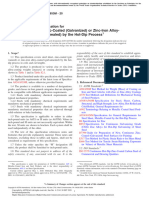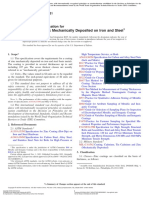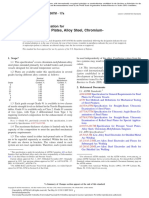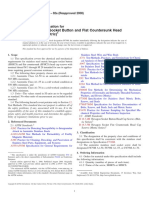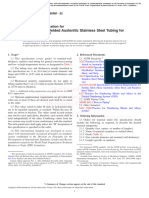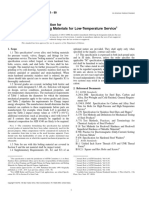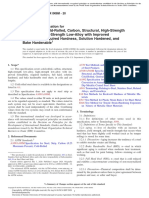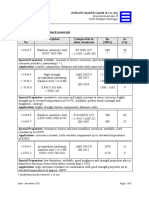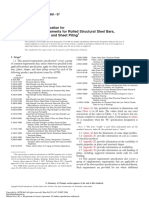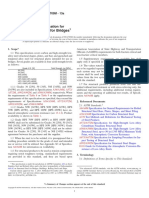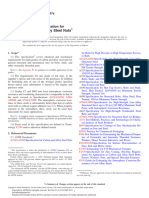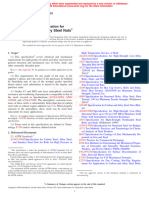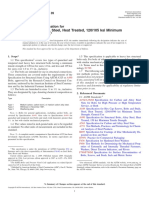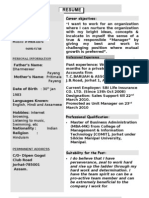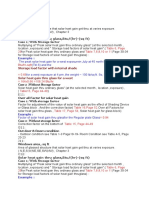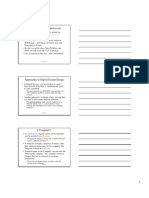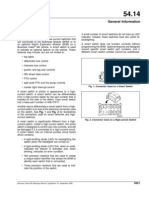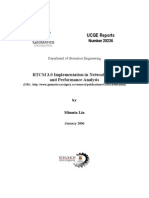Astm A563-07a
Astm A563-07a
Uploaded by
Jhonata ChimeloCopyright:
Available Formats
Astm A563-07a
Astm A563-07a
Uploaded by
Jhonata ChimeloOriginal Title
Copyright
Available Formats
Share this document
Did you find this document useful?
Is this content inappropriate?
Copyright:
Available Formats
Astm A563-07a
Astm A563-07a
Uploaded by
Jhonata ChimeloCopyright:
Available Formats
Designation: A563 − 07a
Standard Specification for
Carbon and Alloy Steel Nuts1
This standard is issued under the fixed designation A563; the number immediately following the designation indicates the year of
original adoption or, in the case of revision, the year of last revision. A number in parentheses indicates the year of last reapproval. A
superscript epsilon (´) indicates an editorial change since the last revision or reapproval.
This standard has been approved for use by agencies of the Department of Defense.
1. Scope* for Bolts for High Pressure or High Temperature Service,
2
1.1 This specification covers chemical and mechanical or Both
requirements for eight grades of carbon and alloy steel nuts for A242/A242M Specification for High-Strength Low-Alloy
general structural and mechanical uses on bolts, studs, and Structural Steel
other externally threaded parts. A307 Specification for Carbon Steel Bolts and Studs, 60 000
PSI Tensile Strength
NOTE 1—See Appendix X1 for guidance on suitable application of nut A325 Specification for Structural Bolts, Steel, Heat Treated,
grades.
120/105 ksi Minimum Tensile Strength
1.2 The requirements for any grade of nut may, at the A354 Specification for Quenched and Tempered Alloy Steel
supplier’s option, and with notice to the purchaser, be fulfilled Bolts, Studs, and Other Externally Threaded Fasteners
by furnishing nuts of one of the stronger grades specified A394 Specification for Steel Transmission Tower Bolts,
herein unless such substitution is barred in the inquiry and Zinc-Coated and Bare
purchase order. A449 Specification for Hex Cap Screws, Bolts and Studs,
1.3 Grades C3 and DH3 nuts have atmospheric corrosion Steel, Heat Treated, 120/105/90 ksi Minimum Tensile
resistance and weathering characteristics comparable to that of Strength, General Use
the steels covered in Specifications A242/A242M, A588/ A490 Specification for Structural Bolts, Alloy Steel, Heat
A588M, and A709/A709M. The atmospheric corrosion resis- Treated, 150 ksi Minimum Tensile Strength
tance of these steels is substantially better than that of carbon A588/A588M Specification for High-Strength Low-Alloy
steel with or without copper addition (see 5.2). When properly Structural Steel, up to 50 ksi [345 MPa] Minimum Yield
exposed to the atmosphere, these steels can be used bare Point, with Atmospheric Corrosion Resistance
(uncoated) for many applications. A687 Specification for High-Strength Nonheaded Steel
Belts and Studs4
NOTE 2—A complete metric companion to Specification A563 has been A709/A709M Specification for Structural Steel for Bridges
developed—A563M; therefore, no metric equivalents are presented in this
specification. A751 Test Methods, Practices, and Terminology for Chemi-
cal Analysis of Steel Products
1.4 Terms used in this specification are defined in Termi- B695 Specification for Coatings of Zinc Mechanically De-
nology F1789 unless otherwise defined herein. posited on Iron and Steel
D3951 Practice for Commercial Packaging
2. Referenced Documents F606 Test Methods for Determining the Mechanical Proper-
2.1 ASTM Standards:3 ties of Externally and Internally Threaded Fasteners,
A194/A194M Specification for Carbon and Alloy Steel Nuts Washers, Direct Tension Indicators, and Rivets
F812/F812M Specification for Surface Discontinuities of
Nuts, Inch and Metric Series
1
This specification is under the jurisdiction of ASTM Committee F16 on
F1789 Terminology for F16 Mechanical Fasteners
Fasteners and is the direct responsibility of Subcommittee F16.02 on Steel Bolts, F2329 Specification for Zinc Coating, Hot-Dip, Require-
Nuts, Rivets and Washers. ments for Application to Carbon and Alloy Steel Bolts,
Current edition approved Dec. 1, 2007. Published January 2008. Originally Screws, Washers, Nuts, and Special Threaded Fasteners
approved in 1966. Last previous edition approved in 2007 as A563 – 07. DOI:
10.1520/A0563-07A. G101 Guide for Estimating the Atmospheric Corrosion Re-
2
For ASME Boiler and Pressure Vessel Code applications see related Specifi- sistance of Low-Alloy Steels
cation SA – 563 in Section II of that Code.
3
For referenced ASTM standards, visit the ASTM website, www.astm.org, or
contact ASTM Customer Service at service@astm.org. For Annual Book of ASTM
4
Standards volume information, refer to the standard’s Document Summary page on Withdrawn. The last approved version of this historical standard is referenced
the ASTM website. on www.astm.org.
*A Summary of Changes section appears at the end of this standard
Copyright © ASTM International, 100 Barr Harbor Drive, PO Box C700, West Conshohocken, PA 19428-2959. United States
Copyright by ASTM Int'l (all rights reserved); 1
A563 − 07a
2.2 ANSI Standards: 4.7.3 When mechanically deposited is specified, the fasten-
ANSI B1.1 Unified Screw Threads5 ers shall be zinc coated by the mechanical deposition process
ANSI B18.2.2 Square and Hex Nuts5 in accordance with the requirements of Class 55 of Specifica-
tion B695.
3. Ordering Information 4.7.4 When no preference is specified, the supplier may
3.1 Orders for nuts under this specification shall include the furnish either a hot-dip zinc coating in accordance with
following: Specification F2329, or a mechanically deposited zinc coating
in accordance with Specification B695, Class 55. Threaded
3.1.1 Quantity (number of nuts),
components (bolts and nuts) shall be coated by the same
3.1.2 Nominal size and thread series of nuts,
zinc-coating process and the supplier’s option is limited to one
3.1.3 Style of nut (for example, heavy hex),
process per item with no mixed processes in a lot.
3.1.4 Grade of nut, 4.7.5 Hot-dip zinc-coated nuts shall be tapped after zinc
3.1.5 Zinc Coating—Specify the zinc-coating process re- coating.
quired, for example, hot-dip, mechanically deposited, or no 4.7.6 Mechanically deposited zinc-coated nuts for assembly
preference (see 4.7), with mechanically deposited zinc-coated bolts shall be tapped
3.1.6 Other Finishes—Specify other protective finish if oversize prior to zinc coating and need not be retapped
required, afterwards.
3.1.7 ASTM designation and year of issue, and
3.1.8 Supplementary or special requirements. 4.8 Lubricant:
4.8.1 Hot-dip and mechanically deposited zinc-coated
NOTE 3—An example of an ordering description follows: 1000 7⁄8-9 Grade DH nuts shall be provided with an additional lubricant
heavy hex nuts, Grade DH, hot-dip zinc-coated, and lubricated, ASTM which shall be clean and dry to the touch (see Supplementary
A563–XX.
Requirement S1 to specify lubrication requirements for plain
finish nuts).
4. Materials and Manufacture
4.8.2 See Supplementary Requirement S2 for option to
4.1 Steel for nuts shall be made by the open-hearth, basic- specify a dye in the lubricant.
oxygen, or electric-furnace process except that steel for Grades
O, A, and B nuts may be made by the acid-bessemer process. 5. Chemical Composition
4.2 Nuts may be made cold or hot by forming, pressing, or 5.1 Grades O, A, B, C, D, and DH shall conform to the
punching or may be machined from bar stock. chemical composition specified in Table 1.
4.3 Grades DH and DH3 nuts shall be heat treated by 5.2 Grades C3 and DH3 shall conform to the chemical
quenching in a liquid medium from a temperature above the composition specified in Table 2. See Guide G101 for methods
transformation temperature and tempering at a temperature of of estimating the atmospheric corrosion resistance of low alloy
at least 800°F. steels.
4.4 Grades C and D nuts made of steel having carbon 5.3 Resulfurized or rephosphorized steel, or both, are not
content not exceeding 0.20 %, phosphorus not exceeding subject to rejection based on product analysis for sulfur or
0.04 %, and sulfur not exceeding 0.05 % by heat analysis may phosphorus.
be heat treated by quenching in a liquid medium from a 5.4 Application of heats of steel to which bismuth, sele-
temperature above the transformation temperature and need not nium, tellurium, or lead has been intentionally added shall not
be tempered. When this heat treatment is used, there shall be be permitted for Grades D, DH, and DH3.
particular attention to the requirements in 6.1.1.
4.5 Grades C, C3, and D nuts made of any steel permitted TABLE 1 Chemical Requirements for Grades O, A, B, C, D, and
DH Nuts
for these grades may be heat treated by quenching in a liquid
medium from a temperature above the transformation tempera- Grade of Composition, %
Nut Analysis Carbon Manganese, Phospho- Sulfur,
ture and tempering at a temperature of at least 800°F.
min rus, max max
4.6 Threads shall be formed by tapping or machining.
4.7 Zinc Coatings, Hot-Dip and Mechanically Deposited: O, A, B, C heat 0.55 max ... 0.12 0.15A
4.7.1 When zinc-coated fasteners are required, the pur- product 0.58 max ... 0.13B ...
chaser shall specify the zinc coating process, for example, DC heat 0.55 max 0.30 0.04 0.05
hot-dip, mechanically deposited, or no preference. product 0.58 max 0.27 0.048 0.058
4.7.2 When hot-dip is specified, the fasteners shall be
heat 0.20–0.55 0.60 0.04 0.05
zinc-coated by the hot-dip process in accordance with the DHC product 0.18–0.58 0.57 0.048 0.058
requirements of Specification F2329. A
For Grades O, A, and B a sulfur content of 0.23 % max is acceptable with the
purchasers approval.
B
Acid bessemer steel only.
C
For Grades D and DH a sulfur content of 0.05 – 0.15 % is acceptable provided
5
Available from American National Standards Institute (ANSI), 25 W. 43rd St., the manganese is 1.35 % min.
4th Floor, New York, NY 10036, http://www.ansi.org.
Copyright by ASTM Int'l (all rights reserved); 2
A563 − 07a
TABLE 2 Chemical Requirements for Grades C3 and DH3 Nuts
Element Composition, %
Classes for Grade C3 NutsA Grade DH3
N A B C D E F Nuts
Carbon:
Heat analysis ... 0.33–0.40 0.38–0.48 0.15–0.25 0.15–0.25 0.20–0.25 0.20–0.25 0.20–0.53
Product analysis ... 0.31–0.42 0.36–0.50 0.14–0.26 0.14–0.26 0.18–0.27 0.19–0.26 0.19–0.55
Manganese:
Heat analysis ... 0.90–1.20 0.70–0.90 0.80–1.35 0.40–1.20 0.60–1.00 0.90–1.20 0.40 min
Product analysis ... 0.86–1.24 0.67–0.93 0.76–1.39 0.36–1.24 0.56–1.04 0.86–1.24 0.37 min
Phosphorus:
Heat analysis 0.07–0.15 0.040 max 0.06–0.12 0.035 max 0.040 max 0.040 max 0.040 max 0.046 max
Product analysis 0.07–0.155 0.045 max 0.06–0.125 0.040 max 0.045 max 0.045 max 0.045 max 0.052 max
Sulfur:
Heat analysis 0.050 max 0.050 max 0.050 max 0.040 max 0.050 max 0.040 max 0.040 max 0.050 max
Product analysis 0.055 max 0.055 max 0.055 max 0.045 max 0.055 max 0.045 max 0.045 max 0.055 max
Silicon:
Heat analysis 0.20–0.90 0.15–0.35 0.30–0.50 0.15–0.35 0.25–0.50 0.15–0.35 0.15–0.35 ...
Product analysis 0.15–0.95 0.13–0.37 0.25–0.55 0.13–0.37 0.20–0.55 0.13–0.37 0.13–0.37 ...
Copper:
Heat analysis 0.25–0.55 0.25–0.45 0.20–0.40 0.20–0.50 0.30–0.50 0.30–0.60 0.20–0.40 0.20 min
Product analysis 0.22–0.58 0.22–0.48 0.17–0.43 0.17–0.53 0.27–0.53 0.27–0.63 0.17–0.43 0.17 min
Nickel:
Heat analysis 1.00 max 0.25–0.45 0.50–0.80 0.25–0.50 0.50–0.80 0.30–0.60 0.20–0.40 0.20 minB
Product analysis 1.03 max 0.22–0.48 0.47–0.83 0.22–0.53 0.47–0.83 0.27–0.63 0.17–0.43 0.17 min
Chromium:
Heat analysis 0.30–1.25 0.45–0.65 0.50–0.75 0.30–0.50 0.50–1.00 0.60–0.90 0.45–0.65 0.45 min
Product analysis 0.25–1.30 0.42–0.68 0.47–0.83 0.27–0.53 0.45–1.05 0.55–0.95 0.42–0.68 0.42 min
Vanadium:
Heat analysis ... ... ... 0.020 min ... ... ... ...
Product analysis ... ... ... 0.010 min ... ... ... ...
Molybdenum:
Heat analysis ... ... 0.06 max ... 0.10 max ... ... 0.15 minB
Product analysis ... ... 0.07 max ... 0.11 max ... ... 0.14 min
Titanium:
Heat analysis ... ... ... ... 0.05 max ... ... ...
Product analysis ... ... ... ... ... ... ... ...
A
C3 nuts may be made of any of the above listed material classes. Selection of the class shall be at the option of the manufacturer.
B
Nickel or molybdenum may be used.
5.5 Chemical analyses shall be performed in accordance 7. Dimensions
with Test Methods, Practices, and Terminology A751. 7.1 Unless otherwise specified, nuts shall be plain (un-
6. Mechanical Properties coated) and shall conform to the dimensions prescribed in
ANSI B18.2.2.
6.1 Hardness:
7.2 Hex and hex-slotted nuts over 11⁄2 to 2 in. inclusive
6.1.1 The hardness of nuts of each grade shall not exceed
shall have dimensions conforming to ANSI B18.2.2 calculated
the maximum hardness specified for the grade in Table 3.
using the formulas for the 11⁄4 through 11⁄2-in. size range in
6.1.2 Jam nuts, slotted nuts, nuts smaller in width across
Appendix III (Formulas for Nut Dimensions) of ANSI B18.2.2.
flats or thickness than standard hex nuts (7.1), and nuts that
would require a proof load in excess of 160 000 lbf may be 7.3 Threads: Plain (Uncoated) Nuts
furnished on the basis of minimum hardness requirements 7.3.1 Unless otherwise specified, the threads shall conform
specified for the grade in Table 3, unless proof load testing is to the dimensions for coarse threads with Class 2 B tolerances
specified in the inquiry and purchase order. prescribed in ANSI B1.1.
6.2 Proof Load: 7.4 Threads: Nuts Hot Dip Zinc Coated Specification
6.2.1 Nuts of each grade, except those listed in 6.1.2, shall F2329( 4.7.2)
withstand the proof load stress specified for the grade, size, 7.4.1 Nuts to be used on bolts with Class 2A threads before
style, thread series, and surface finish of the nut in Table 3 and hot-dip zinc coating, and then hot-dip zinc coated in accor-
Table 4. dance with Specification F2329, shall be tapped oversize after
6.2.2 Nuts hot dip or mechanically zinc coated in accor- coating, to the minimum and maximum thread dimensions in
dance with 4.7.2 or 4.7.3 shall be proof load tested after zinc Table 5. The major and minor diameters shall also be increased
coating and overtapping.6 by the allowance to provide the corresponding minimum and
maximum major and minor diameters.
6
Rotational capacity test procedures, nut rotations, and acceptance criteria are a
7.5 Threads: Nuts With Other Coatings
function of the bolt with which the nuts will be used. When required, they are 7.5.1 Nuts to be used on bolts mechanically zinc coated or
covered by the applicable bolt specification. on bolts hot-dip zinc-coated to a specification other than
Copyright by ASTM Int'l (all rights reserved); 3
A563 − 07a
TABLE 3 Mechanical Requirements
Nuts with UNC, 8 UN, 6 UN and Coarser Pitch Threads
Grade of Nut Nominal Nut Size, Style of Nut Proof Load Stress, ksiA Hardness
in. Non-Zinc-Coated Zinc-Coated Brinell Rockwell
NutsB NutsB min max min max
O ⁄ to 11⁄2
14 square 69 52 103 302 B55 C32
A ⁄ to 11⁄2
14 square 90 68 116 302 B68 C32
O ⁄ to 11⁄2
14 hex 69 52 103 302 B55 C32
A ⁄ to 11⁄2
14 hex 90 68 116 302 B68 C32
B 1⁄4 to 1 hex 120 90 121 302 B69 C32
B 11⁄8 to 11⁄2 hex 105 79 121 302 B69 C32
DC 1⁄4 to 11⁄2 hex 135 135 159 352 B84 C38
DHD 1⁄4 to 11⁄2 hex 150 150 248 352 C24 C38
DH3 1⁄2 to 1 hex 150 150 248 352 C24 C38
A ⁄ to 4
14 heavy hex 100 75 116 302 B68 C32
B ⁄ to 1
14 heavy hex 133 100 121 302 B69 C32
B 11⁄8 to 11⁄2 heavy hex 116 87 121 302 B69 C32
CC 1⁄4 to 4 heavy hex 144 144 143 352 B78 C38
C3 1⁄4 to 4 heavy hex 144 144 143 352 B78 C38
DC 1⁄4 to 4 heavy hex 150 150 159 352 B84 C38
DHD 1⁄4 to 4 heavy hex 175 150 248 352 C24 C38
DH3 1⁄4 to 4 heavy hex 175 150 248 352 C24 C38
A ⁄ to 11⁄2
14 hex thick 100 75 116 302 B68 C32
B 1⁄4 to 1 hex thick 133 100 121 302 B69 C32
B 11⁄8 to 11⁄2 hex thick 116 87 121 302 B69 C32
DC 1⁄4 to 11⁄2 hex thick 150 150 159 352 B84 C38
DHD 1⁄4 to 11⁄2 hex thick 175 175 248 352 C24 C38
Nuts with UNF, 12 UN, and Finer Pitch Threads
O ⁄ to 11⁄2
14 hex 65 49 103 302 B55 C32
A ⁄ to 11⁄2
14 hex 80 60 116 302 B68 C32
B 1⁄4 to 1 hex 109 82 121 302 B69 C32
B 11⁄8 to 11⁄2 hex 94 70 121 302 B69 C32
DC 1⁄4 to 11⁄2 hex 135 135 159 352 B84 C38
DHD 1⁄4 to 11⁄2 hex 150 150 248 352 C24 C38
A ⁄ to 4
14 heavy hex 90 68 116 302 B68 C32
B ⁄ to 1
14 heavy hex 120 90 121 302 B69 C32
B 1 ⁄ to 11⁄2
18 heavy hex 105 79 121 302 B69 C32
DC 1⁄4 to 4 heavy hex 150 150 159 352 B84 C38
DHD 1⁄4 to 4 heavy hex 175 150 248 352 C24 C38
A ⁄ to 11⁄2
14 hex thick 90 68 116 302 B68 C32
B 1⁄4 to 1 hex thick 120 90 121 302 B69 C32
B 11⁄8 to 11⁄2 hex thick 105 79 121 302 B69 C32
DC 1⁄4 to 11⁄2 hex thick 150 150 159 352 B84 C38
DHD 1⁄4 to 11⁄2 hex thick 175 175 248 352 C24 C38
A
To determine nut proof load in pounds, multiply the appropriate nut proof load stress by the tensile stress area of the thread. Stress areas for UNC, UNF, and 8 UN
thread series are given in Table 4.
B
Non-zinc-coated nuts are nuts intended for use with externally threaded fasteners which have a plain (nonplated or noncoated) finish or have a plating or coating of
insufficient thickness to necessitate overtapping the nut thread to provide assemblability. Zinc-coated nuts are nuts intended for use with externally threaded fasteners
which are hot-dip zinc-coated, mechanically zinc-coated, or have a plating or coating of sufficient thickness to necessitate overtapping the nut thread to provide
assemblability.
C
Nuts made in accordance to the requirements of Specification A194/A194M, Grade 2 or Grade 2H, and marked with their grade symbol are acceptable equivalents
for Grades C and D nuts. When A194 zinc-coated inch series nuts are supplied, the zinc coating, overtapping, lubrication and rotational capacity testing shall be in
accordance with Specification A563.
D
Nuts made in accordance with the requirements of Specification A194/A194M, Grade 2H, and marked with its grade symbol are an acceptable equivalent for Grade
DH nuts. When A194 zinc-coated inch series nuts are supplied, the zinc coating, overtapping, lubrication and rotational capacity testing shall be in accordance with
Specification A563.
Specification F2329, or otherwise hot-dip coated, shall be 7.5.2 When specifically permitted by the purchaser, nuts for
tapped oversize by a diametral amount sufficient to permit bolts with electrodeposited coating, such as cadmium, zinc,
assembly on the coated bolt thread, unless other requirements and so forth, or with chemically applied coating may be tapped
are specified in the inquiry or purchase order.
Copyright by ASTM Int'l (all rights reserved); 4
A563 − 07a
TABLE 4 Tensile Stress Areas TABLE 5 Thread Dimensions and Overtapping Allowances for
Nominal UNC Nominal UNF Nominal 8 UN Nuts Hot Dip Zinc Coated per Specification F2329
Size– Tensile Stress Size- Tensile Stress Size– Tensile Stress Nominal Nut Diametral Al- Pitch Diameter, in.
Threads Area,As in.2 Threads AreaAs in.2 Threads Area,As in.2 Size, in. and lowance, in.A min max
per Inch per Inch per Inch Pitch
⁄ –20
14 0.0318 ⁄ –28
14 0.0364 ... ... 0.250-20 0.016 0.2335 0.2384
⁄ –18
5 16 0.0524 ⁄ –24
5 16 0.0580 ... ... 0.312-18 0.017 0.2934 0.2987
3⁄8 –16 0.0775 3⁄8 –24 0.0878 ... ... 0.375-16 0.017 0.3514 0.3571
7⁄16 –14 0.1063 7⁄16 –20 0.1187 ... ... 0.437-14 0.018 0.4091 0.4152
1⁄2 –13 0.1419 1⁄2 –20 0.1599 ... ... 0.500-13 0.018 0.4680 0.4745
9⁄16 –12 0.182 9⁄16 –18 0.203 ... ... 0.562-12 0.020 0.5284 0.5352
5⁄8 –11 0.226 5⁄8 –18 0.256 ... ... 0.625-11 0.020 0.5860 0.5932
3⁄4 –10 0.334 3⁄4 –16 0.373 ... ... 0.750-10 0.020 0.7050 0.7127
7⁄8 –9 0.462 7⁄8 –14 0.509 ... ... 0.875-9 0.022 0.8248 0.8330
1–8 0.606 1–12 0.663 1–8 0.606 1.000-8 0.024 0.9428 0.9516
11⁄8 –7 0.763 11⁄8 –12 0.856 11⁄8 –8 0.790 1.125-8 0.024 1.0678 1.0768
11⁄4 –7 0.969 11⁄4 –12 1.073 11⁄4 –8 1.000 1.125-7 0.024 1.0562 1.0656
13⁄8 –6 1.155 13⁄8 –12 1.315 13⁄8 –8 1.233 1.250-8 0.024 1.1928 1.2020
11⁄2 –6 1.405 11⁄2 –12 1.581 11⁄2 –8 1.492 1.250-7 0.024 1.1812 1.1908
13⁄4 –5 1.90 ... ... 13⁄4 –8 2.08 1.375-8 0.027 1.3208 1.3301
2–41⁄2 2.50 ... ... 2–8 2.77 1.375-6 0.027 1.2937 1.3041
21⁄4 –41⁄2 3.25 ... ... 21⁄4 –8 3.56 1.500-8 0.027 1.4458 1.4553
21⁄2 –4 4.00 ... ... 21⁄2 –8 4.44 1.500-6 0.027 1.4187 1.4292
23⁄4 –4 4.93 ... ... 23⁄4 –8 5.43 1.750-5 0.050 1.6701 1.6817
3–4 5.97 ... ... 3–8 6.51 2.000-4.5 0.050 1.9057 1.9181
31⁄4 –4 7.10 ... ... 31⁄4 –8 7.69 2.250-4.5 0.050 2.1557 2.1683
31⁄2 –4 8.33 ... ... 3 ⁄2 –8
1 8.96 2.500-4 0.050 2.3876 2.4011
33⁄4 –4 9.66 ... ... 33⁄4 –8 10.34 2.750-4 0.050 2.6376 2.6513
4–4 11.08 ... ... 4–8 11.81 3.000-4 0.050 2.8876 2.9015
A
The stress area is calculated as follows: 3.250-4 0.050 3.1376 3.1517
s
3.500-4 0.050 3.3876 3.4019
F
A s 5 0.7854 D 2
0.9743
n G 2
3.750-4
3.750-4
0.050
0.050
3.6376
3.6376
3.6521
3.6521
4.000-4 0.050 3.8876 3.9023
A
These allowances also apply to the minimum and maximum major and minor
where: diameters.
As = stress area, in.2,
D = nominal size, in., and
n = threads per inch.
9.2.5 Surface finish.
oversize by a diametral amount sufficient to permit assembly
on the coated bolt thread. 9.3 Unless otherwise specified in the inquiry and purchase
7.5.3 The allowable oversize tapping shall not exceed that order, the number of tests for each lot of required property shall
specified in Table 5. be as follows:
Number of
8. Workmanship Number of Nuts in Lot Specimens
8.1 Surface discontinuity limits shall be in accordance with 800 and under 1
801 to 8 000 2
Specification F812/F812M. 8 001 to 22 000 3
Over 22 000 5
9. Number of Tests
9.4 If any test specimen shows flaws, it may be discarded
9.1 The requirements of this specification shall be met in and another specimen substituted.
continuous mass production for stock, and the manufacturer
shall make sample inspections to ensure that the product 9.5 Should any specimen fail to meet the requirements of
conforms to the specified requirements. Additional tests of any specified test, double the number of specimens from the
individual shipments of material are not ordinarily contem- same lot shall be tested for this property, in which case all of
plated. Individual heats of steel are not identified in the finished the additional specimens shall meet the specifications.
product.
10. Test Methods
9.2 When additional tests are specified in the inquiry and
purchase order, a lot, for purposes of selecting test samples, 10.1 Tests shall be conducted in accordance with Test
shall consist of all material offered for inspection at one time Methods F606.
that has the following common characteristics:
9.2.1 Grade, 11. Report
9.2.2 Nominal size, 11.1 When specified in the order, the manufacturer shall
9.2.3 Style of nut, furnish a test report certified to be the last completed set of
9.2.4 Thread series and class, and mechanical tests for each stock size in each shipment.
Copyright by ASTM Int'l (all rights reserved); 5
A563 − 07a
12. Inspection Hex nuts made to the requirements of DH3 shall be marked
12.1 If the inspection described in 12.2 is required by the with the symbol HX3 on one face. In addition, the manufac-
purchaser, it shall be specified in the inquiry and contract or turer may add other distinguishing marks indicating that the nut
order. is atmospheric corrosion resistant and of a weathering type.
12.2 The inspector representing the purchaser shall have 14.7 In addition, nuts of Grades C, C3, D, DH, and DH3 and
free entry to all parts of the manufacturer’s works that concern hex nuts made to the requirements of DH3, shall be marked
the manufacture of the material ordered. The manufacturer with a symbol to identify the manufacturer or private label
shall afford the inspector all reasonable facilities to satisfy him distributor, as appropriate.
that the material is being furnished in accordance with this 14.8 Marks may be raised or depressed at the option of the
specification. All tests and inspections required by the specifi- manufacturer. However, if markings are located on the bearing
cation that are requested by the purchaser’s representative shall surface, they shall be depressed.
be made before shipment, and shall be conducted as not to
14.9 Grade and manufacturer’s or private label distributor’s
interfere unnecessarily with the operation of the works.
identification shall be separate and distinct. The two identifi-
13. Rejection and Rehearing cations shall preferably be in different locations and, when on
the same level, shall be separated by at least two spaces.
13.1 Material that fails to conform to the requirements of
this specification may be rejected. Rejection should be reported NOTE 4—See Table 3 for marking of equivalent nuts made in accor-
to the producer or supplier promptly and in writing. In case of dance with requirements of Specification A194/A194M.
dissatisfaction with the results of the test, the producer or
supplier may make claim for a rehearing. 15. Packaging and Package Marking
15.1 Packaging:
14. Product Marking
15.1.1 Unless otherwise specified, packaging shall be in
14.1 Nuts made to the requirements of Grades O, A, and B accordance with Practice D3951.
are not required to be marked unless individual marking is 15.1.2 When special packaging requirements are required,
specified in the inquiry and order. When individual marking is they shall be defined at the time of the inquiry and order.
required, the mark shall be the grade letter symbol on one face
15.2 Package Marking:
of the nut.
15.2.1 Each shipping unit shall include or be plainly marked
14.2 Heavy hex nuts made to the requirements of Grade C with the following information:
(Note 4) shall be marked on one face with three circumferential 15.2.1.1 ASTM designation and grade,
marks 120° apart. 15.2.1.2 Size,
14.3 Heavy hex nuts made to the requirements of Grade C3 15.2.1.3 Name and brand or trademark of the manufacturer,
shall be marked on one face with three circumferential marks 15.2.1.4 Number of pieces,
120° apart and the numeral 3. In addition, the manufacturer 15.2.1.5 Purchase order number, and
may add other distinguishing marks indicating that the nut is 15.2.1.6 Country of origin.
atmospheric corrosion resistant and of a weathering type.
14.4 Nuts made to the requirements of Grade D shall be 16. Responsibility
marked with the grade symbol, D (Note 4) on one face. 16.1 The party responsible for the fastener shall be the
14.5 Nuts made to the requirements of Grade DH shall be organization that supplies the fastener to the purchaser.
marked with the grade symbol, DH (Note 4) on one face.
14.6 Heavy hex nuts made to the requirements of Grade 17. Keywords
DH3 shall be marked with the grade symbol DH3 on one face. 17.1 alloy steel; carbon steel; nuts; steel; weathering steel
SUPPLEMENTARY REQUIREMENTS
The following supplementary requirement shall be applied only when specified by the purchaser on
the contract or order. Details of these supplementary requirements shall be agreed upon in writing
between the manufacturer and purchaser. This supplementary requirement shall in no way negate any
requirement of the specification itself.
S1. Supplementary Lubricant Requirements for Nuts S2. Lubricant Dye
S1.1 Nuts, regardless of specified finish, shall be provided S2.1 In addition to the requirements of Supplementary
with an additional lubricant that shall be clean and dry to the Requirement S1, the lubricant shall have a contrasting color so
touch. that it’s presence is visually obvious.
Copyright by ASTM Int'l (all rights reserved); 6
A563 − 07a
S3. Lubricant Placement bearing face or both bearing faces, as required, or ( 3) such
The lubricant shall be applied to specified surfaces on the other specific lubricant placement criteria as are agreed to
nuts, such as (1) principally only those portions which are between the purchaser and the user.
threaded, or (2) on threaded portions and either only one
APPENDIX
(Nonmandatory Information)
X1. INTENDED APPLICATION
X1.1 Table X1.1 gives additional information for the in-
tended application of nuts.
Copyright by ASTM Int'l (all rights reserved); 7
A563 − 07a
TABLE X1.1 Nut and Bolt Suitability Guide
Copyright by ASTM Int'l (all rights reserved); 8
A563 − 07a
SUMMARY OF CHANGES
Committee F16 has identified the location of selected changes to this standard since the last issue (A563–07)
that may impact the use of this standard. (Approved Dec. 1, 2007.)
(1) Sections 4.7.3 and 4.7.4 were revised.
Committee F16 has identified the location of selected changes made to this standard since the last issue,
A563–04a, that may impact the use of this standard.
(1) Changed the reference hot dip zinc coating specification
from Specification A153/A153MGr. C, to Specification F2329.
ASTM International takes no position respecting the validity of any patent rights asserted in connection with any item mentioned
in this standard. Users of this standard are expressly advised that determination of the validity of any such patent rights, and the risk
of infringement of such rights, are entirely their own responsibility.
This standard is subject to revision at any time by the responsible technical committee and must be reviewed every five years and
if not revised, either reapproved or withdrawn. Your comments are invited either for revision of this standard or for additional standards
and should be addressed to ASTM International Headquarters. Your comments will receive careful consideration at a meeting of the
responsible technical committee, which you may attend. If you feel that your comments have not received a fair hearing you should
make your views known to the ASTM Committee on Standards, at the address shown below.
This standard is copyrighted by ASTM International, 100 Barr Harbor Drive, PO Box C700, West Conshohocken, PA 19428-2959,
United States. Individual reprints (single or multiple copies) of this standard may be obtained by contacting ASTM at the above
address or at 610-832-9585 (phone), 610-832-9555 (fax), or service@astm.org (e-mail); or through the ASTM website
(www.astm.org). Permission rights to photocopy the standard may also be secured from the ASTM website (www.astm.org/
COPYRIGHT/).
Copyright by ASTM Int'l (all rights reserved); 9
You might also like
- ASTM A653-A653-20 Standart Specification For Steel Sheet, Zinc-Coated (Galvanized) or Zinc-Iron Alloy-Coated (Galvannealed) by The Hot-Dip ProcessDocument13 pagesASTM A653-A653-20 Standart Specification For Steel Sheet, Zinc-Coated (Galvanized) or Zinc-Iron Alloy-Coated (Galvannealed) by The Hot-Dip ProcessAarón Escorza MistránNo ratings yet
- A276a276m 2023Document8 pagesA276a276m 20237620383tlNo ratings yet
- Astm B695 - 2021Document6 pagesAstm B695 - 2021Danny Triwibowo100% (1)
- Astm A563Document12 pagesAstm A563Jose Rueda100% (2)
- ASTM B564 (2011) - Standard Specification For Nickel Alloy ForgingsDocument11 pagesASTM B564 (2011) - Standard Specification For Nickel Alloy Forgingsanoop100% (1)
- Experiment 3Document5 pagesExperiment 3Ji Sian LeeNo ratings yet
- Astm - A568 A568m 15Document31 pagesAstm - A568 A568m 15Joel MedellinNo ratings yet
- Bolts - ASTM F3125Document4 pagesBolts - ASTM F3125rahuljoagNo ratings yet
- ASTM-A449: Licensed by Information Handling Services Licensed by Information Handling ServicesDocument7 pagesASTM-A449: Licensed by Information Handling Services Licensed by Information Handling ServicesRoland CepedaNo ratings yet
- Astm A787Document7 pagesAstm A787rgi178No ratings yet
- Asme B18.2.1 PDFDocument37 pagesAsme B18.2.1 PDFJUAN C100% (1)
- Stainless Steel Socket Head Cap Screws: Standard Specification ForDocument8 pagesStainless Steel Socket Head Cap Screws: Standard Specification ForMarcelo BarretosNo ratings yet
- Electric-Resistance-Welded Carbon and Alloy Steel Mechanical TubingDocument21 pagesElectric-Resistance-Welded Carbon and Alloy Steel Mechanical TubingIsaac ZTNo ratings yet
- Pressure Vessel Plates, Alloy Steel, Chromium-Molybdenum: Standard Specification ForDocument6 pagesPressure Vessel Plates, Alloy Steel, Chromium-Molybdenum: Standard Specification Foralucard375No ratings yet
- Ge Host Communication ReferenceDocument45 pagesGe Host Communication Referenceshimon100% (1)
- Memoria de Calculo Separadores BifasicosDocument1 pageMemoria de Calculo Separadores BifasicosJhonnatan Fredy Gomez DominguezNo ratings yet
- Astm A563Document9 pagesAstm A563mhmgola100% (1)
- Astm F436F436M.36576Document8 pagesAstm F436F436M.36576Oscar Álvarez100% (1)
- A108Document4 pagesA108Mathew CherianNo ratings yet
- F2833-11 Standard Specification For Corrosion Protective Fastener Coatings With Zinc Rich Base Coat and Aluminum Organic-Inorganic TypeDocument3 pagesF2833-11 Standard Specification For Corrosion Protective Fastener Coatings With Zinc Rich Base Coat and Aluminum Organic-Inorganic TypehugoNo ratings yet
- F879MDocument6 pagesF879MmsbarretosNo ratings yet
- Astm B16-10Document5 pagesAstm B16-10Francisco Villasmil OlivaresNo ratings yet
- Astm A564Document10 pagesAstm A564chetan_thakur4278100% (1)
- Astm A574Document7 pagesAstm A574Michael Frereault-LerouxNo ratings yet
- Astm F959-09Document5 pagesAstm F959-09Nhật NguyễnNo ratings yet
- Astm F436M.-11Document5 pagesAstm F436M.-11abhishek yadav100% (1)
- F568MDocument9 pagesF568Maldert_pathNo ratings yet
- Astm A320-22Document8 pagesAstm A320-22Juan Ramirez100% (2)
- Astm A269 A269m 22Document4 pagesAstm A269 A269m 22Excel Hydro Pneumatics (INDIA) EHPINo ratings yet
- Astm b574Document4 pagesAstm b574Ananka FastenersNo ratings yet
- High-Carbon Anti-Friction Bearing Steel: Standard Specification ForDocument4 pagesHigh-Carbon Anti-Friction Bearing Steel: Standard Specification ForTriveni Forge QCNo ratings yet
- A307 PDFDocument5 pagesA307 PDFxaviereduardoNo ratings yet
- Steel, Sheet and Strip, High-Strength, Low-Alloy, Hot-Rolled and Cold-Rolled, With Improved Atmospheric Corrosion ResistanceDocument4 pagesSteel, Sheet and Strip, High-Strength, Low-Alloy, Hot-Rolled and Cold-Rolled, With Improved Atmospheric Corrosion ResistancePham Huu Loc Ho100% (1)
- Asme-B18 2 6mDocument21 pagesAsme-B18 2 6mthanh_121No ratings yet
- Astm F3125 F3125M 18Document6 pagesAstm F3125 F3125M 18Amine ait talebNo ratings yet
- Astm A106 PDFDocument13 pagesAstm A106 PDFDanny Milton Silva VasquezNo ratings yet
- Astm A-579Document6 pagesAstm A-579martinNo ratings yet
- Astm A320-A320m-99Document8 pagesAstm A320-A320m-99NadhiraNo ratings yet
- Astm A1008 2020Document11 pagesAstm A1008 2020reza acbariNo ratings yet
- Standard Specification For Steel Sheet Zinc Coated Galvanized or Zinc Iron Alloy Coated Galvannealed by The Hot Dip ProcessDocument4 pagesStandard Specification For Steel Sheet Zinc Coated Galvanized or Zinc Iron Alloy Coated Galvannealed by The Hot Dip ProcessarchahmedassafNo ratings yet
- Astm A29Document16 pagesAstm A29Nacer KisyNo ratings yet
- Astm A311 - 2015 - ObsoletoDocument4 pagesAstm A311 - 2015 - ObsoletoRicardo Ricardo100% (1)
- Aerospace Standard Materials - Mechanical Properties - Issue 12 - 2015Document6 pagesAerospace Standard Materials - Mechanical Properties - Issue 12 - 2015Leandro González De CeccoNo ratings yet
- Csa G40.21 PDFDocument4 pagesCsa G40.21 PDFmecano1No ratings yet
- A-449 - 00Document6 pagesA-449 - 00kanario2006No ratings yet
- Astm B505Document7 pagesAstm B505Syed Shoaib RazaNo ratings yet
- Steel Bars, Selection Guide, Composition, and Mechanical PropertiesDocument9 pagesSteel Bars, Selection Guide, Composition, and Mechanical PropertiesAnıl ZiylanNo ratings yet
- Astm A314 PDFDocument3 pagesAstm A314 PDFMatyash MatyashNo ratings yet
- Astm A6Document5 pagesAstm A6SHYAM SINGHNo ratings yet
- Zinc/Aluminum Corrosion Protective Coatings For FastenersDocument2 pagesZinc/Aluminum Corrosion Protective Coatings For FastenersAmandeep SinghNo ratings yet
- ASME B18-2-4-6M Metric Heavy Hex NutsDocument16 pagesASME B18-2-4-6M Metric Heavy Hex Nutsronaldoge100% (1)
- ASME B18 8 100M 2000 Spring PinsDocument57 pagesASME B18 8 100M 2000 Spring Pinshcsharma1967No ratings yet
- Astm 555 555M - 2016Document6 pagesAstm 555 555M - 2016Nguyễn Văn Thuận PhátNo ratings yet
- Astm A506Document4 pagesAstm A506Fabio SegattoNo ratings yet
- Astm F3111-16 PDFDocument15 pagesAstm F3111-16 PDFHa Dao SongNo ratings yet
- Surface Vehicle Standard: Rev. SEP81Document42 pagesSurface Vehicle Standard: Rev. SEP81anupthattaNo ratings yet
- Astm A709Document7 pagesAstm A709Ahmed Abdel NabiNo ratings yet
- Astm A572Document4 pagesAstm A572Kaushal KishoreNo ratings yet
- ASTM A563 Tuercas de Aleacion Acero y CarbonoDocument9 pagesASTM A563 Tuercas de Aleacion Acero y CarbonoMarco GonzaNo ratings yet
- Astm A563 15Document4 pagesAstm A563 15meisam davoodabadiNo ratings yet
- ASTM A563 - 07 Standard Specification For Carbon and Alloy Steel NutsDocument8 pagesASTM A563 - 07 Standard Specification For Carbon and Alloy Steel NutsDagoberto AguilarNo ratings yet
- Astm A563 A563m 21Document7 pagesAstm A563 A563m 21zhang binNo ratings yet
- Structural Bolts, Steel, Heat Treated, 120/105 Ksi Minimum Tensile StrengthDocument8 pagesStructural Bolts, Steel, Heat Treated, 120/105 Ksi Minimum Tensile StrengthJay GaneshNo ratings yet
- 13 Plastic Injection Molding Problems and SolutionsDocument14 pages13 Plastic Injection Molding Problems and SolutionsHicham AhmamsiNo ratings yet
- Concealed Door Closer: SpecificationsDocument2 pagesConcealed Door Closer: SpecificationsAmit JamdadeNo ratings yet
- Best Practice in Boiler Water Treatment Part 2Document6 pagesBest Practice in Boiler Water Treatment Part 2Adrian MicuNo ratings yet
- Oracle RXi ReportsDocument32 pagesOracle RXi ReportsSriram KalidossNo ratings yet
- CV of Hemanta GogoiDocument3 pagesCV of Hemanta GogoiAsia TicrhinoNo ratings yet
- Dell Latitude D505: Intuitive Form Factors & DesignDocument2 pagesDell Latitude D505: Intuitive Form Factors & DesignAkshit BhagraNo ratings yet
- JURUTERA Jul'22 CompilationDocument48 pagesJURUTERA Jul'22 CompilationKit Keong FOONGNo ratings yet
- Support Details For ASHRAE Heat Load Calculation SheetDocument8 pagesSupport Details For ASHRAE Heat Load Calculation SheetShravanNo ratings yet
- Visio-STO - VARIOUS - HVAC - PHM (HVAC)Document1 pageVisio-STO - VARIOUS - HVAC - PHM (HVAC)dimaspangestu231No ratings yet
- ECE/CS 3724 - Microprocessors: ComputerDocument10 pagesECE/CS 3724 - Microprocessors: ComputerSaleha MaqsoodNo ratings yet
- Calculate Area ArcviewDocument2 pagesCalculate Area ArcviewIsrael GutierrezNo ratings yet
- An Investigation of The Abrasive Wear Behavior of Ductile CaDocument6 pagesAn Investigation of The Abrasive Wear Behavior of Ductile CalucianoNo ratings yet
- FAQ's of C ProgrammingDocument42 pagesFAQ's of C ProgrammingP Venu Gopala RaoNo ratings yet
- METS2CaseStudy19-Fuel System-Why DLNDocument17 pagesMETS2CaseStudy19-Fuel System-Why DLNvahid_strNo ratings yet
- The Performance Analysis of Linux Networking - Packet ReceivingDocument27 pagesThe Performance Analysis of Linux Networking - Packet Receivinga_whizNo ratings yet
- DIN EN 14399 10 System HRC. Bolt and Nut Assemblies With CalDocument23 pagesDIN EN 14399 10 System HRC. Bolt and Nut Assemblies With CalNiranjan KumarNo ratings yet
- Edexcel A-LEVEL PHY2 June 2007 QPDocument16 pagesEdexcel A-LEVEL PHY2 June 2007 QPapi-3726022No ratings yet
- Zexel VRZ PumpDocument12 pagesZexel VRZ PumpOscar Diaz Galvez80% (10)
- CHEM Exp 3Document3 pagesCHEM Exp 3Henry ParrNo ratings yet
- Prefill Valve: RE 20478, Edition: 2017-12, Bosch Rexroth AGDocument20 pagesPrefill Valve: RE 20478, Edition: 2017-12, Bosch Rexroth AGBademianNo ratings yet
- Interruptores InteligentesDocument12 pagesInterruptores InteligentesedgarwalterNo ratings yet
- 2013 47 Summer Wiring Matters Voltage OptimisationDocument5 pages2013 47 Summer Wiring Matters Voltage OptimisationXosé Nel Piedra FernándezNo ratings yet
- Preparing A Wet MountDocument2 pagesPreparing A Wet MountCath QuitorioNo ratings yet
- Timetable For Offshore Programme - Week 6 (20 - 21 October 2018) (SEM I - SESI 2018/2019)Document6 pagesTimetable For Offshore Programme - Week 6 (20 - 21 October 2018) (SEM I - SESI 2018/2019)Mohd Kazi Abd RahmanNo ratings yet
- Turck MS24 112 RDocument2 pagesTurck MS24 112 RDavid Ulises Yunganina ZeaNo ratings yet
- Building Science 2 ReportDocument13 pagesBuilding Science 2 ReportLucas Wong100% (1)
- RTCM 06.23236.MLinDocument151 pagesRTCM 06.23236.MLinOscar CuadradoNo ratings yet
